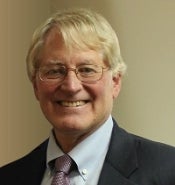How did the first living cells come into being from the earth’s molecular soup 3.5 billion years ago?
“Despite much speculation — maybe RNA came first, or proteins, or chemical networks — there’s not yet a consensus origins story,” says Distinguished Professor Ken Dill from the State University of New York.
“New insights are coming from thinking not just about life’s molecules, but about biology’s dynamics — its process of adaptation. The Darwinian evolution process must have preceded the origins of life. This, and the apparent needle-in-a-haystack nature of sequence space, indicate a key role of proteins in life’s origin," he says.
Dill, a biophysicist and chemist, is known by many for his significant contributions to the folding pathways of proteins.
On March 28 and 29, the Laufer Family Endowed Professor of Physical Biology and Founding Director of the Laufer at Stony Brook University will be the featured speaker for the School of Molecular Sciences’ Eyring Lecture Series at Arizona State University's Tempe campus.
The general lecture on March 28, titled “The Future of Physical Modeling of Biomolecules and Cells,” will be presented at 6 p.m. in the Marston Theater in ISTB4. A reception will precede the general lecture in the lobby of ISTB4 from 5–5:40 p.m.
The technical lecture, “The Origins of Life: An Uncanny Resemblance to the Old Protein Folding Problem” will take place at 3 p.m. on March 29 in NEEB 105.
The Eyring Lecture Series is named in honor of the late Leroy Eyring, an ASU Regents Professor of chemistry and former department chair, whose instructional and research accomplishments and professional leadership at ASU helped to bring the Department of Chemistry and Biochemistry into international prominence. The Eyring Materials Center and the Navrotsky Eyring Center for Materials of the Universe at ASU are named in his honor.
The Eyring lectures are part of an interdisciplinary distinguished lecture series dedicated to stimulating discussion by renowned scientists who are at the cutting edge of their respective fields. Each series consists of a leadoff presentation to help communicate the excitement and the challenge of science to the university and community. Past lecturers have included Nobel laureates Ahmed Zewail, Jean-Marie Lehn, Harry Gray, Richard Smalley, Yuan T. Lee, Richard Schrock, John Goodenough, Mario Capecchi and, most recently awarded, Carolyn Bertozzi.
“Looking back 40 years, biomolecule modeling is no longer limited by our 'molecular dynamics' methods, our forcefields, or our tools for predicting protein structures or docking poses or even binding affinities,” Dill says. “Computational modeling is now a trusted tool for drug discovery, and machine learning is bringing new horsepower.”
What are the challenges for the next 40 years? Dill goes on to explain that we need top-down theories and models (cell function and molecular structure, phenotype and genotype, rather than the reverse) that explain why cells do what they do, how fitness landscapes choose their embodiments in molecules, the roles of environment, and the multiplicities of the paths and molecules that can embody cellular function.
Dill received bachelor's and master's degrees from MIT in mechanical engineering in 1971; a PhD in biology with B.H. Zimm at the University of California, San Diego; did postdoctoral research with P.J. Flory at Stanford University; and was on the faculty in the pharmaceutical chemistry department at the University of California San Francisco for 28 years.
His research is at the intersection of statistical physics with the biophysics of proteins and cells. He has worked on the physics of protein folding, computational structural biology, proteostasis in the cell and on foundational problems in nonequilibrium statistical physics.
Dill is a past president of the Biophysical Society and a co-author of two textbooks. He received the Hans Neurath Award from the Protein Society, the Max Delbruck Award from the American Physical Society and the Sackler Prize in Biophysics. Dill is a member of the U.S. National Academy of Sciences and the American Academy of Arts and Sciences.
More Science and technology

ASU postdoctoral researcher leads initiative to support graduate student mental health
Olivia Davis had firsthand experience with anxiety and OCD before she entered grad school. Then, during the pandemic and as a result of the growing pressures of the graduate school environment, she…

ASU graduate student researching interplay between family dynamics, ADHD
The symptoms of attention deficit hyperactivity disorder (ADHD) — which include daydreaming, making careless mistakes or taking risks, having a hard time resisting temptation, difficulty getting…

Will this antibiotic work? ASU scientists develop rapid bacterial tests
Bacteria multiply at an astonishing rate, sometimes doubling in number in under four minutes. Imagine a doctor faced with a patient showing severe signs of infection. As they sift through test…
